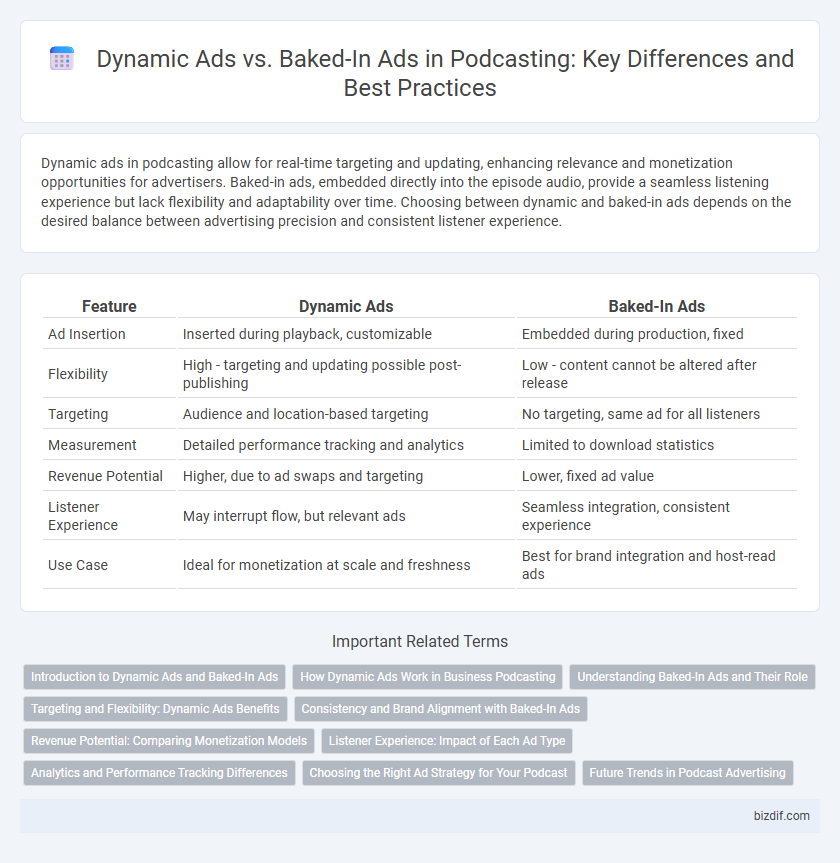Dynamic ads in podcasting allow for real-time targeting and updating, enhancing relevance and monetization opportunities for advertisers. Baked-in ads, embedded directly into the episode audio, provide a seamless listening experience but lack flexibility and adaptability over time. Choosing between dynamic and baked-in ads depends on the desired balance between advertising precision and consistent listener experience.
Table of Comparison
| Feature | Dynamic Ads | Baked-In Ads |
|---|---|---|
| Ad Insertion | Inserted during playback, customizable | Embedded during production, fixed |
| Flexibility | High - targeting and updating possible post-publishing | Low - content cannot be altered after release |
| Targeting | Audience and location-based targeting | No targeting, same ad for all listeners |
| Measurement | Detailed performance tracking and analytics | Limited to download statistics |
| Revenue Potential | Higher, due to ad swaps and targeting | Lower, fixed ad value |
| Listener Experience | May interrupt flow, but relevant ads | Seamless integration, consistent experience |
| Use Case | Ideal for monetization at scale and freshness | Best for brand integration and host-read ads |
Introduction to Dynamic Ads and Baked-In Ads
Dynamic ads in podcasting allow advertisers to insert targeted messages that can be updated or changed over time based on listener location, demographics, or campaign goals. Baked-in ads are embedded directly into the podcast episode during production, remaining static and consistent across all listens. Understanding these two ad formats is crucial for optimizing ad effectiveness and listener experience in podcast marketing strategies.
How Dynamic Ads Work in Business Podcasting
Dynamic ads in business podcasting use real-time technology to insert targeted advertisements based on listener demographics, behavior, and geographic location, optimizing relevance and engagement. These ads can be updated or rotated without altering the original podcast episode, allowing advertisers to tailor messages for specific campaigns or time-sensitive promotions. This flexibility enhances monetization potential by delivering personalized content that adapts to evolving listener profiles and market trends.
Understanding Baked-In Ads and Their Role
Baked-in ads are advertisements permanently embedded within the podcast audio during production, making them inseparable from the episode once published. This approach ensures consistent ad delivery to every listener, contributing to a seamless and uninterrupted listening experience. Advertisers value baked-in ads for their reliability and the enduring relevance of branded messages over time, compared to dynamic ads that can change or expire.
Targeting and Flexibility: Dynamic Ads Benefits
Dynamic ads in podcasting offer precise targeting by inserting customized advertisements based on listener demographics, location, and behavior, enhancing relevance and engagement. These ads provide flexibility to update or rotate content in real-time without altering the original podcast audio, allowing advertisers to adapt messages to current promotions or audiences. Baked-in ads, in contrast, lack this adaptability, as they are permanently embedded, limiting the ability to tailor ads post-production.
Consistency and Brand Alignment with Baked-In Ads
Baked-in ads offer unmatched consistency by being seamlessly integrated into the podcast episode, ensuring the message aligns perfectly with the show's tone and style. This approach strengthens brand alignment by allowing hosts to deliver personalized endorsements, enhancing listener trust and engagement. Unlike dynamic ads, baked-in ads maintain their impact over time as they remain part of the episode, providing a cohesive brand experience throughout the podcast's lifespan.
Revenue Potential: Comparing Monetization Models
Dynamic ads in podcasting offer higher revenue potential by enabling targeted, time-sensitive advertisements that adapt to listener demographics and campaign updates, maximizing advertiser value. Baked-in ads provide a consistent, integrated listener experience but often yield lower long-term revenue due to their static nature and limited flexibility for advertisers. Podcasters prioritizing scalable monetization frequently choose dynamic ads to capitalize on ongoing ad sales and audience segmentation capabilities.
Listener Experience: Impact of Each Ad Type
Dynamic ads tailor advertisements based on listener data and current context, leading to more relevant and timely messages that enhance engagement without interrupting the flow. Baked-in ads, embedded permanently within episodes, provide a seamless and consistent listening experience but may feel outdated or irrelevant over time. Both ad types influence listener satisfaction, with dynamic ads offering adaptability and baked-in ads ensuring uninterrupted storytelling.
Analytics and Performance Tracking Differences
Dynamic ads in podcasting allow advertisers to insert targeted content in real-time, enabling precise analytics on listener engagement and conversion metrics, which enhances performance tracking accuracy. Baked-in ads, embedded directly into the episode audio, limit post-distribution tracking capabilities, making it challenging to measure ad effectiveness and listener response dynamically. Advanced analytics platforms leverage dynamic ad technology to provide granular insights, such as listener demographics and ad interaction rates, driving data-driven campaign optimizations.
Choosing the Right Ad Strategy for Your Podcast
Dynamic ads offer real-time targeting and flexibility, allowing podcasters to update or rotate advertisements based on listener demographics and campaign performance data. Baked-in ads provide a seamless listening experience with consistent messaging but lack adaptability once published, often benefiting sponsor relationship stability. Selecting the right ad strategy depends on goals like maximizing revenue through dynamic targeting or enhancing listener engagement via integrated content.
Future Trends in Podcast Advertising
Dynamic ads in podcasting offer real-time targeting and adaptability, enabling advertisers to tailor messages based on listener demographics and current campaigns. Baked-in ads, embedded directly within episodes, provide a seamless listener experience but lack flexibility and update capability over time. Future trends indicate a shift toward hybrid models combining the precision of dynamic ads with the authenticity of baked-in placements, driven by advances in AI and data analytics to maximize engagement and ROI.
Dynamic ads vs baked-in ads Infographic

 bizdif.com
bizdif.com